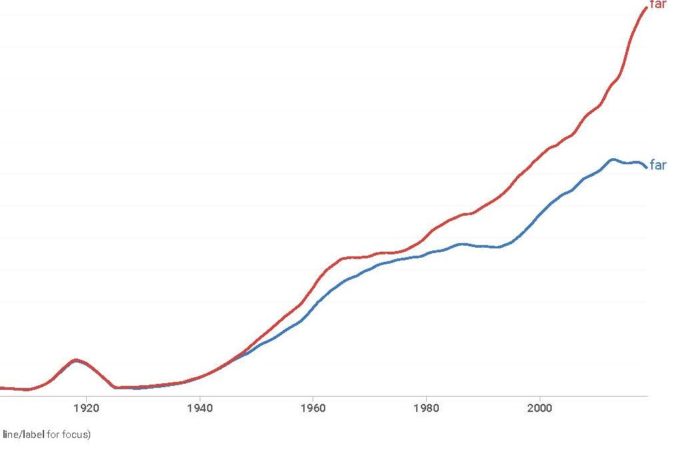If conservatives think the opinion-molders in American culture are biased against them, they are correct.
Just for fun I used Google’s Ngram feature to track the use of some pejorative political terms. Ngram traces how we employ language and particular words and phrases over time. It uses Google Books as its database. It reports how frequently words and phrases appear in books from year to year. I limited my searches to American sources and excluded other English-speaking countries.
Initially, I searched to find out the frequency of the expressions “far right” and “far left.” “Far right is in red, “far left” in blue. You can find the answer if you click on comparison-far
As the chart shows, each term was used about as frequently as the other until around 1960. I suspect that most of the uses of “far left” and “far right” were not political at all. Instead, they appeared in sentences such as, “When looking for the highway exit, keep to the far right.” But around 1960 prominent writers began smear conservatives like Barry Goldwater and Ronald Reagan as “far right.” A disparity opened up between the terms that persists today.
In the next chart, we see a similar discrepancy between “left wing extremist” and “right wing extremist.” Authors are much more likely (by several orders of magnitude) to refer to someone as an extremist of the right than as an extremist of the left. Click on comparison-extreme wing
This discrepancy also arose during the 1960s. That’s pretty ironic: The 1960s was during the Cold War, when the world was threatened the Communist powers. The Communist nations were governed by totalitarians who by any definition were “far left” or “left wing extremists.” They had enslaved a third of the human population, amassed a huge nuclear arsenal, repeatedly committed acts of aggression against other countries, and were feeding internal subversion in the U.S. and other free nations. Yet when faced with this threat, American opinion-molders preferred to hurl insults at the political right!
I also compared “ultra-conservative” with “ultra-liberal” and “ultraconservative” with “ultraliberal.” Here, the discrepancy is just as marked. But it began earlier in the 20th century—probably with abuse directed against conservatives who opposed the “progressive” movement and the ensuing New Deal. Click on comparison-ultra
This underlying bias helps explain why, other things being equal, principled conservatives tend to have more difficulty being elected to office than candidates perceived as “liberal” or “pragmatic.” Principled conservatives not only face their election opponents; they have to deal with the literary/media culture as well.









